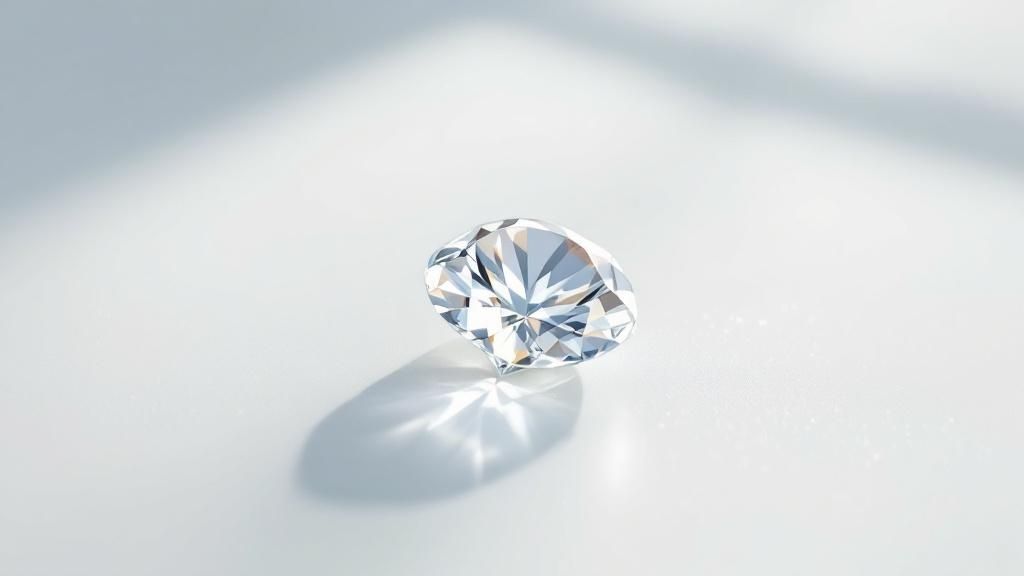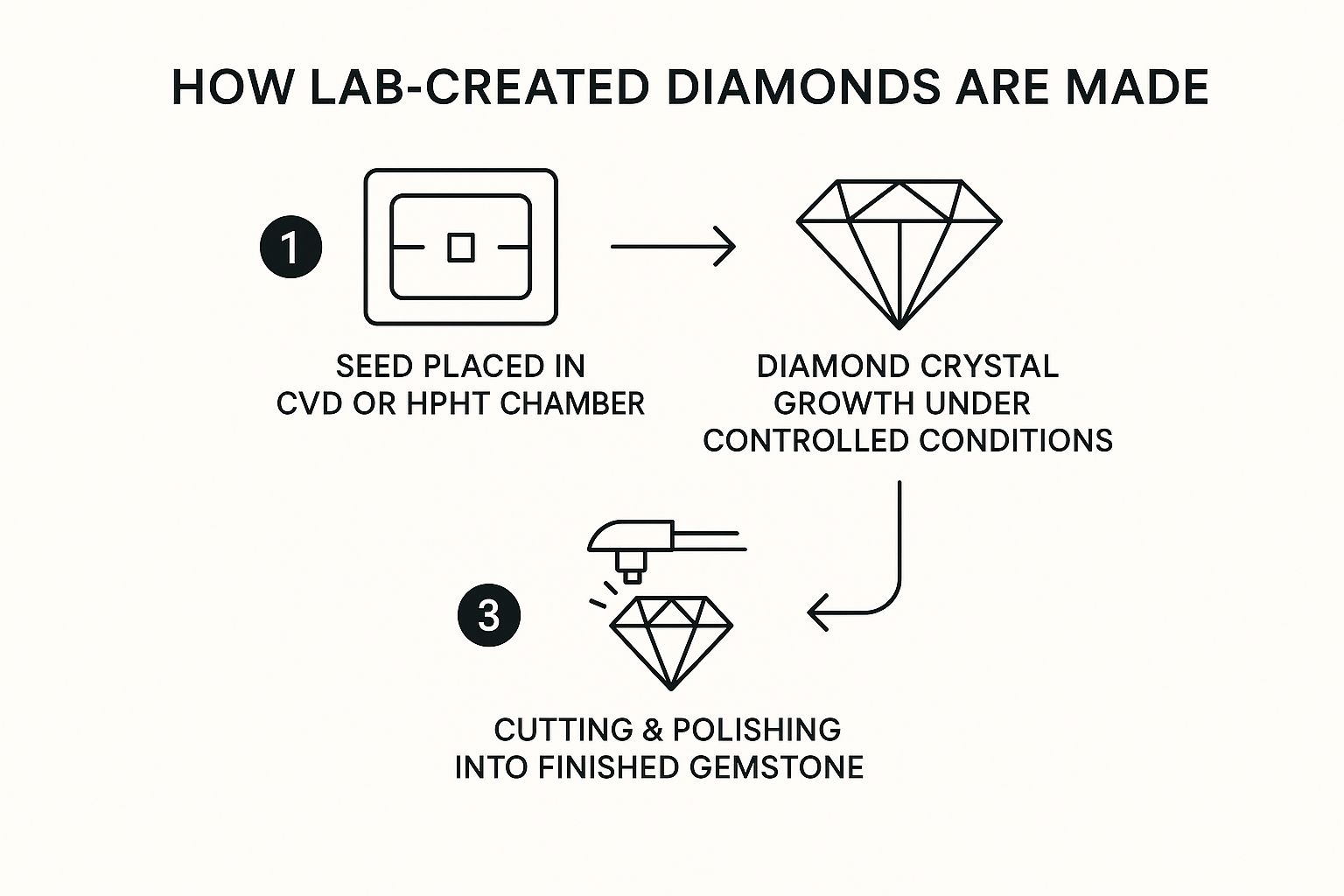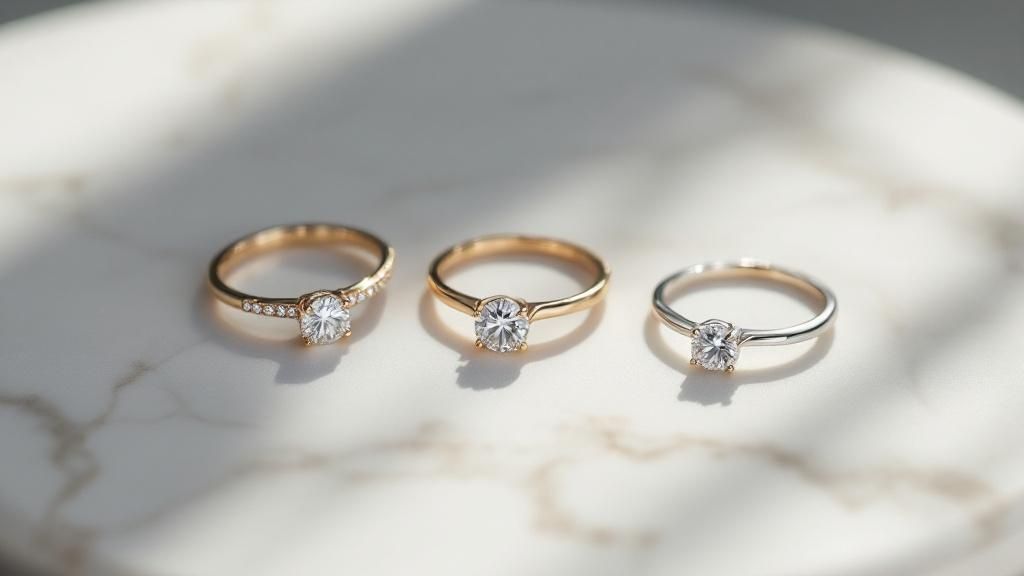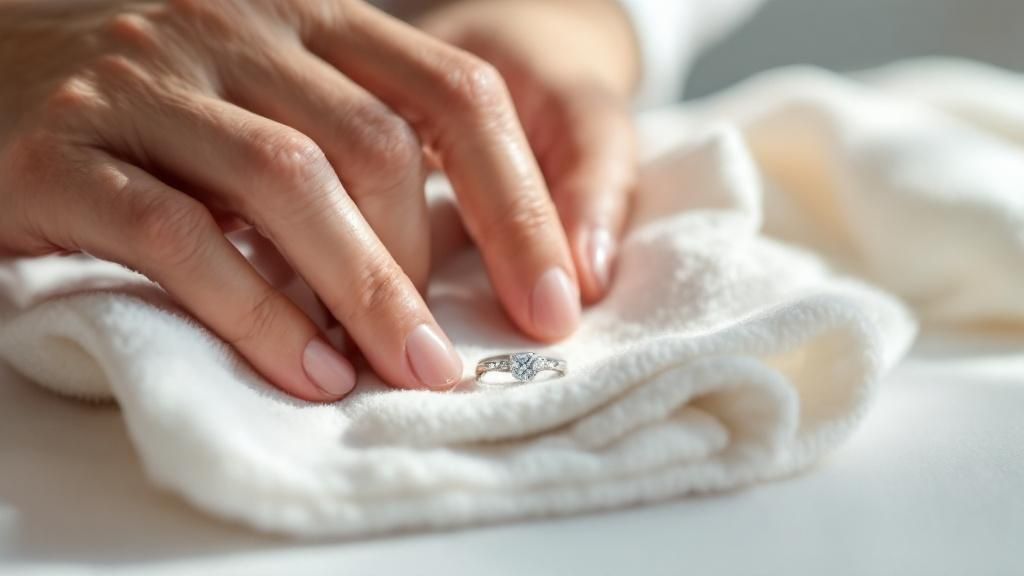A Guide to Lab Created Diamond Rings
- Luke Zucco
- 3 days ago
- 13 min read
Let's be clear from the start: lab-created diamond rings are not imitations. They are 100% real diamonds, sharing the exact same chemical, physical, and optical DNA as diamonds pulled from the earth.
The only thing that separates them is where they began their life. One grew in a controlled lab, and the other formed deep underground millions of years ago. It’s a lot like the difference between ice from a state-of-the-art freezer and ice from a magnificent glacier—both are frozen water, just created in very different environments.
What Are Lab Created Diamond Rings

At their heart, lab-created diamonds are pure, crystallized carbon, just like the ones found in nature. They aren't "fakes" or diamond look-alikes such as cubic zirconia or moissanite. Instead, scientists use incredible technology to recreate the intense heat and pressure that forge diamonds deep within the Earth's mantle.
Because they are made of the same stuff, lab diamonds have the same stunning brilliance, fire, and legendary hardness—a perfect 10 on the Mohs scale. What does this mean for you? Well, to the naked eye, even a seasoned jeweler can't tell the difference between a lab-grown and a mined diamond. It takes specialized equipment to identify their origin.
The Modern Appeal of Lab Grown Gems
The surge in popularity for lab-created diamond rings isn't just a fleeting trend; it's a reflection of what today's buyers truly value. These gems present a fantastic alternative without asking you to compromise on beauty or quality.
Here’s why so many people are making the switch:
Ethical Sourcing: Grown in a controlled setting, every lab diamond has a transparent and traceable origin. This completely sidesteps the ethical shadows of traditional diamond mining, giving you guaranteed peace of mind that your stone is conflict-free.
Environmental Sustainability: While the process requires a lot of energy, its environmental footprint is a fraction of what large-scale mining operations leave behind. For many, this makes them a more responsible and eco-conscious choice.
Exceptional Value: This is often the biggest win for shoppers. Lab-created diamonds typically cost 30-40% less than mined diamonds of the same size and quality. This means you can get a larger, more brilliant stone without stretching your budget.
To give you a quick side-by-side view, here's how they stack up.
Lab Created vs Mined Diamonds at a Glance
This table breaks down the core similarities and differences, helping you see exactly what you're getting with each choice.
Attribute | Lab Created Diamond | Mined Diamond |
|---|---|---|
Composition | Pure Carbon (C) | Pure Carbon (C) |
Hardness | 10/10 (Mohs Scale) | 10/10 (Mohs Scale) |
Appearance | Identical | Identical |
Origin | Grown in a lab | Mined from the earth |
Price | Typically 30-40% less | Higher |
Ethics | Guaranteed conflict-free | Can have ethical concerns |
Rarity | Not rare | Naturally rare |
Ultimately, both are brilliant, beautiful, and built to last a lifetime. The choice simply comes down to what matters most to you.
This isn't just a minor shift in taste; it's a genuine market transformation. The global lab-grown diamonds market hit a value of USD 27.24 billion in 2024 and is set to keep growing.
This incredible growth is powered by shoppers who are more informed than ever before. As people learn about the benefits, the demand for luxury that is ethical, sustainable, and affordable continues to climb. You can learn more from the lab-grown diamond market forecast on univdatos.com.
The Science of Creating a Diamond
Ever wonder how a lab-created diamond comes to be? It's a fascinating mix of geology and cutting-edge science. Instead of inventing something entirely new, scientists have learned to perfectly recreate the intense, high-pressure environment found deep within the Earth's crust. They're essentially fast-forwarding a natural process, turning basic carbon into the brilliant gemstone we all know and love.
The whole process starts with a tiny sliver of a pre-existing diamond, known as a diamond seed. Think of it as a template or a starter crystal. From this small foundation, one of two incredible methods takes over to grow a larger, gem-quality diamond. While the techniques differ, the stunning result is the same.
High-Pressure High-Temperature (HPHT)
The High-Pressure High-Temperature (HPHT) method is exactly what it sounds like—it’s the brute-force approach that mirrors how diamonds form in nature. You can think of it as the world’s most advanced pressure cooker.
A diamond seed is placed into a chamber along with a source of pure, graphite-based carbon. The machine then subjects it to truly staggering conditions: pressures of around 1.5 million pounds per square inch and scorching heat reaching 2,700°F (1,500°C). This intense environment melts the carbon, which then crystallizes onto the seed, atom by atom. Over time, it grows into a rough diamond.
The infographic below walks through the journey from a simple seed to a finished, polished gem.

As you can see, once the rough diamond is formed—whether through HPHT or the method we'll discuss next—the final cutting and polishing stages are identical to those for a mined diamond.
Chemical Vapor Deposition (CVD)
The Chemical Vapor Deposition (CVD) method is a bit more finessed. Instead of immense pressure, it uses a specialized vacuum chamber—almost like a "diamond greenhouse." A diamond seed is placed inside, and the chamber is filled with carbon-rich gases, such as methane.
Once heated, these gases break down, releasing their individual carbon atoms. These atoms then settle, or "rain down," onto the cooler diamond seed, bonding to it and slowly building up the crystal, layer by delicate layer.
The CVD process is a meticulous, layer-by-layer construction. It can take several weeks to grow a single high-quality, one-carat diamond, showcasing the precision and patience required for this scientific art form.
Whether born from the intense pressure of HPHT or the delicate layering of CVD, the result is a rough diamond that is physically, chemically, and optically identical to one pulled from the earth. These stones are then handed over to master cutters and polishers who transform them into the brilliant gems you see in lab created diamond rings. It's a true diamond, simply born from human ingenuity rather than geological chance.
Lab Diamonds vs. Mined Diamonds: Is There a Difference?
If you put a lab-created diamond and a mined diamond next to each other, you wouldn't be able to tell them apart. I couldn't, and neither can most gemologists without specialized equipment. Why? Because they are physically and chemically identical, and they're graded using the exact same international standards.
World-renowned labs like the GIA and IGI use the famous 4 Cs—Cut, Color, Clarity, and Carat—to grade both. A VVS1 clarity, D color lab diamond has to meet the same strict benchmarks as its natural twin. So, you’re not choosing between a "real" diamond and a lesser alternative; you’re choosing between two identical products. And if you're ever worried about fakes (which are a totally different thing), it helps to know how to spot fake diamonds in our complete guide.
The real differences aren't in how they look or how long they'll last. The distinctions that truly matter to most of us are their price and their origin story.
The Clear Advantage of Price
For many people, this is the deciding factor. Lab-created diamond rings are always more affordable than mined diamonds of the same size and quality. On average, you can expect to pay around 30-40% less for a lab-grown stone.
This isn’t because they’re lower quality—it's all about the supply chain. Making a diamond in a lab is a sophisticated process, but it's far more direct than funding enormous mining operations that involve years of exploration, excavation, and a long chain of distributors.
What does this mean for you? It gives you amazing flexibility with your budget. You could get a larger or higher-quality diamond than you ever thought you could afford. Or, you could take those savings and put them toward a more elaborate setting or a beautiful matching wedding band.
This accessibility is completely changing the jewelry world. Younger buyers especially are drawn to the incredible value lab-grown diamonds offer. In fact, a major generational shift is happening right now, with projections for 2025 showing that over 70% of millennial buyers globally prefer lab-grown diamond rings. This trend, detailed in a fascinating consumer trend report on varniya.com, is fueled by both price and a growing awareness of where our products come from.
The Ethical and Environmental Impact
Beyond your wallet, the conversation around diamonds has shifted to their journey. When you choose a lab-created diamond ring, you're also choosing peace of mind and a much lighter environmental footprint.
Here’s a quick rundown of what that means:
Traceability: You know exactly where a lab diamond came from. Its origin is fully documented, from the moment it was created to the day it was cut. The path of a mined diamond, on the other hand, can be murky and difficult to trace, sometimes crossing through conflict zones.
Environmental Disruption: Diamond mining is an incredibly invasive process. It involves moving massive amounts of earth, which can cause deforestation, destroy ecosystems, and erode soil. Lab facilities use a lot of energy, but they operate in a controlled, contained space with a fraction of the impact.
Human Impact: The term "blood diamond" exists for a tragic reason—diamond profits have funded devastating wars. While regulations like the Kimberley Process have made a difference, serious concerns about exploitative labor practices still exist in some mining regions. Lab diamonds completely avoid these ethical minefields.
For so many of us today, these factors are just as important as the sparkle on our finger. Choosing a lab-created diamond is a way to align modern values with timeless beauty. You get a ring that's not just brilliant and affordable, but one you can feel genuinely good about wearing.
Why Lab-Created Diamonds Are Gaining So Much Traction

The incredible rise of lab-created diamond rings isn't just some fleeting trend. It’s a real, fundamental shift in how we think about luxury, value, and what makes a piece of jewelry special. This change is being steered by a new wave of buyers, especially Millennials and Gen Z, who look at big purchases through a completely different lens.
For this new generation, the story behind a product is just as important as the product itself. They demand transparency. They want to know where things come from, how they were made, and what kind of footprint they leave on the world. The lab-grown diamond industry answers that call perfectly, offering a crystal-clear origin for every single gem.
A New Definition of Value
Today's shoppers are voting with their wallets, and their ethics are leading the way. They're actively looking for brands and products that mirror their own values, putting sustainability and responsible sourcing at the top of their list. This shift in mindset has sent ripples through the jewelry industry, an industry once held up by tradition alone.
The magic of lab-grown diamonds is that they meet these new expectations without asking for any compromise. You get the same breathtaking, forever-durable gemstone, but it comes with a story you can feel genuinely good about. It's conscious consumerism reshaping an entire market right before our eyes.
The global lab-grown diamonds market was valued at around USD 26.05 billion in 2024 and is expected to rocket to USD 97.85 billion by 2034. This isn't just growth; it's a sign of a massive evolution in how we define what's precious.
Confidence Through Technology and Quality
It’s not just about the feel-good factor, either. Technology has been a game-changer in building trust. Early on, some lab diamonds had a reputation for being inconsistent. Not anymore. Modern production methods like HPHT and CVD have been honed to a fine art, now producing consistently flawless, brilliant diamonds of exceptional quality.
This rock-solid reliability means you know you're getting a top-tier gem every time. When you combine that guaranteed quality with major cost savings and the peace of mind that comes with an ethical choice, it’s no wonder the popularity of lab-created diamond rings keeps climbing.
If you're in the planning stages for your own big day, you might also find some inspiration in our guide to unforgettable wedding jewelry ideas for 2025. Ultimately, this movement is about more than just picking a different kind of diamond—it’s about choosing a better story.
How to Choose Your Perfect Diamond Ring

Ready to find the one? Picking out a lab-created diamond ring should be fun, and it really comes down to finding that sweet spot between what you love, what you want to spend, and your own personal style.
The good news is that lab diamonds are graded using the exact same system as mined ones: the famous 4 Cs (Cut, Color, Clarity, and Carat). This gives you a fantastic framework for getting the most sparkle for your money.
Think of it this way: the cut is the single most important factor for brilliance. It’s what makes a diamond dance in the light. When it comes to color and clarity, you have some wiggle room. A nearly colorless stone with tiny inclusions you can't even see with the naked eye is a smart choice that delivers stunning beauty without the top-tier price.
Matching Your Diamond to the Perfect Setting
Once you’ve got a sense of the diamond you want, it’s time to find its home. The setting does more than just hold the stone in place; it gives the ring its entire personality.
Here are a few classic choices to consider:
Solitaire: You can’t go wrong with a classic. A single, stunning diamond on a clean band keeps all the attention right where it belongs—on the stone's fire.
Halo: If you're after that 'wow' factor, a halo setting is your best friend. It frames the main diamond with a circle of smaller stones, making it look bigger and adding a ton of extra sparkle.
Pavé: This setting features tiny diamonds set tightly along the band, creating what looks like a continuous surface of glitter. It’s pure, sophisticated glamour.
The metal matters, too. Platinum is tough and has a cool white sheen that really makes a diamond pop. Yellow gold offers a warm, traditional vibe, while rose gold feels more modern and romantic. Each one brings out a different side of the diamond.
Your ring should feel like you. Don't hesitate to mix and match. A vintage-inspired setting with a modern lab-grown diamond can create a look that's totally unique and absolutely gorgeous.
Styling and Stacking Your Rings
Your lab-created diamond rings are made to be played with. One of the best ways to express your style is by creating a ring stack. This just means layering your engagement ring with a wedding band and maybe a few other rings to build a look that’s all your own.
For more inspiration, you can check out these essential jewelry pieces for your 2025 collection.
By getting familiar with the 4 Cs and picking a setting that speaks to you, you can easily find a ring you'll love wearing every single day.
How to Care for Your Lab-Created Diamond
Think of your lab-created diamond as you would a mined one—because it is one. They’re both the real deal, chemically and physically identical, right down to their perfect 10 on the Mohs scale of hardness. That means your lab diamond is incredibly tough, but it still needs a little TLC to keep that fire and brilliance at its peak.
Over time, everyday life can dull its sparkle. Lotions, oils from your skin, and even dust can build up a thin film on the surface, but don’t worry. A quick, simple cleaning at home is usually all it takes to bring it back to life.
The Best Way to Clean Your Ring at Home
You don't need any fancy jewelry cleaners to keep your lab-grown diamond ring looking brand new. In fact, a few things you already have in your kitchen will work perfectly.
Here’s a simple method that’s both safe and effective:
Mix up a bath: Grab a small bowl and fill it with warm water. Add a few drops of a gentle dish soap—the simpler, the better. Steer clear of anything with heavy moisturizers or abrasive chemicals.
Let it soak: Pop your ring into the soapy water and let it sit for about 20-30 minutes. This little soak will do most of the work for you, gently loosening any gunk and grime.
Give it a gentle scrub: Using a very soft toothbrush (a baby toothbrush is perfect for this), carefully brush around the diamond and setting. Pay special attention to the underside of the stone, as that’s where dirt loves to hide and block the light.
Rinse and dry: Hold the ring under warm running water to rinse away the soap, then pat it dry with a soft, lint-free cloth. A microfiber cloth works wonders here.
A quick word of caution: while the diamond itself is nearly indestructible, the metal band is not. Gold and platinum are much softer, so always use a gentle touch to avoid scratching the setting.
When to Call in a Professional
Even with regular at-home cleanings, it’s a great idea to have a professional jeweler look at your ring about once a year. They have ultrasonic cleaners that can safely blast away any stubborn, deep-set dirt that a simple soak can't reach.
More importantly, they'll inspect the prongs and the overall setting to make sure your beautiful diamond is still snug and secure. Think of it as an annual check-up—it's the best way to catch any potential issues early and ensure your cherished ring stays in perfect condition for years to come.
Answering Your Top Questions About Lab-Grown Diamonds
Even after learning the basics, it's completely normal to have a few lingering questions before committing to a lab-grown diamond ring. Let's tackle some of the most common ones so you can feel completely confident about your decision.
So, Are Lab-Grown Diamonds Actually Real Diamonds?
Yes, they absolutely are. If you take away only one thing, let it be this: lab-grown diamonds are chemically, physically, and optically identical to those pulled from the earth. They're both made of pure, crystallized carbon, which is what gives them that unmistakable hardness and fiery sparkle.
The only thing that separates them is their origin story. One grew in a high-tech lab, the other formed deep underground millions of years ago. Because they are the same exact material, they're even graded by the same world-renowned institutes like GIA and IGI, using the same strict standards.
Can a Jeweler Tell the Difference Just by Looking?
Nope. Not even a trained gemologist can distinguish a lab-grown diamond from a mined one with just their eyes or a standard loupe. Their identical makeup makes them look and feel exactly the same.
It actually takes highly specialized laboratory equipment to spot the microscopic differences in their crystal growth patterns. For total transparency, certified lab diamonds usually have a tiny, invisible laser inscription on their side (the girdle) that identifies them as lab-created.
Without advanced gemological tools, telling them apart is impossible. This is a testament to the fact that you are getting a genuine diamond, just one with a different, more modern history.
What About Resale Value? Do They Hold Their Value?
This is a big one, and it's surrounded by a lot of myths. The truth is, most diamonds—whether mined or lab-grown—are not a financial investment that gains value over time. Like a new car, the resale value for both types of diamonds is almost always significantly lower than what you paid at retail.
The real financial "value" of a lab-grown diamond comes from the massive savings you get on day one. By costing 30-40% less than a mined diamond of the same size and quality, you get way more for your money. You can either pocket the savings or get a bigger, more brilliant stone than you thought you could afford, which is a pretty powerful advantage.
Ready to discover the perfect ring that combines modern values with timeless beauty? Explore the stunning collection of lab created diamond rings at Panther De Luxe Shop and find a piece that tells your unique story. Visit us at https://www.pantherdeluxe.com.

Commentaires